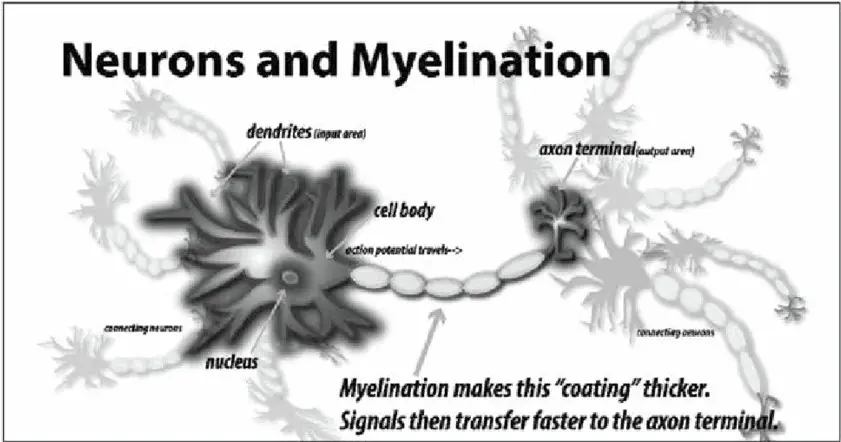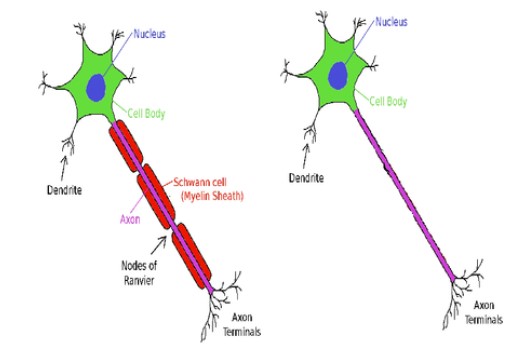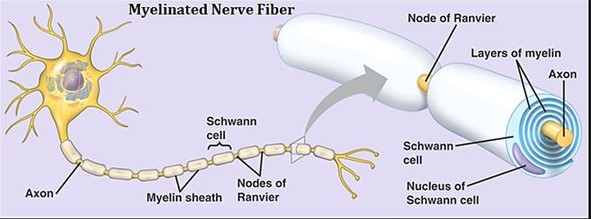The human body is an incredibly complex machine made up of cells, organs, tissues, and neurons. In order for the body to properly function, these components must be able to communicate with each other. In the nervous system, neurons are responsible for carrying electrical signals through long tubular projections called axons.
A major difference between axons is whether or not they are myelinated. In this blog, we will explore the differences between myelinated and unmyelinated axons and how they affect the transmission of electrical signals in the body.
What is myelination

Myelination is an important process that occurs in the nervous system, whereby a layer of fatty material called myelin is wrapped around axons. This layer of insulation helps to improve the speed and efficiency of nerve impulses traveling along the axon. There are two types of axons: myelinated and unmyelinated.
There are two types of axons: myelinated and unmyelinated. Myelinated axons are wrapped with a thick layer of myelin, which helps to speed up the transmission of nerve impulses. On the other hand, unmyelinated axons do not have this protective layer of insulation and so nerve impulses travel more slowly along them.
It is important to note that some axons may have partial myelination, which means that they have a thin layer of myelin, thus providing some degree of insulation but not enough to speed up the transmission of nerve impulses.
Unmyelinated axons
Myelinated axons and unmyelinated axons are two types of nerve fibers that make up our nervous system. They differ in their structure, function, and the speed with which they can transmit signals. Myelinated axons are wrapped in a sheath of myelin, a fatty substance that helps them to conduct electrical signals quickly and efficiently.

Unmyelinated axons, on the other hand, lack this protective myelin sheath, and are much slower in sending signals along the nerve. This is because unmyelinated axons must rely on a slower process of releasing neurotransmitters to send signals down the axon, as opposed to the much faster process of myelinated axons.
Additionally, unmyelinated axons tend to be more sensitive than their myelinated counterparts, making them more prone to damage from physical or chemical stimuli.
Why is myelination important
Myelination is an essential process in the human body, impacting how our nerves transmit signals. Myelination is the process of wrapping an insulating layer of fatty tissue, known as myelin, around nerve fibers. This layer helps to increase the speed and efficiency of electrical signals travelling through the nerves.
This layer helps to increase the speed and efficiency of electrical signals travelling through the nerves. Without it, nerve signals would be much slower and less efficient. The difference between myelinated and unmyelinated axons is that myelinated axons can conduct signals much faster.
The myelin sheath acts as insulation, allowing the signals to travel faster, while unmyelinated axons are slower and can only conduct signals for short distances. Myelination is important for a variety of reasons, such as maintaining brain health, allowing for faster communication throughout the body, and maintaining muscle control.
Types of neurotransmitters in myelinated and unmyelinated axons
When it comes to nerve signals, the difference between myelinated and unmyelinated axons can drastically affect neurotransmitter release and how quickly a signal is transmitted. Myelinated axons are wrapped in a fatty sheath, which helps to speed up the signal by forming an insulating layer.
This allows for faster conduction of nerve impulses and greater efficiency in communication. On the other hand, unmyelinated axons lack the insulation and are slower to conduct signals. The type of neurotransmitter released in myelinated and unmyelinated axons is determined by the type of neuron.
Generally, myelinated axons release glutamate, while unmyelinated axons release acetylcholine. Glutamate is an excitatory neurotransmitter, helping to increase the activity of neurons, while acetylcholine is an inhibitory neurotransmitter, meaning it has the opposite effect.
Therefore, the differences between myelinated and unmyelinated axons not only affect the speed of transmission, but also the type of neurotransmitter released.
The role of myelination in neurological disorders
The role of myelination in neurological disorders is a complex yet fascinating topic. Myelination is the process of coating nerve cells, known as axons, with an insulating layer of fatty tissue called myelin.
This myelin sheath helps axons transmit electrical signals quickly and efficiently. Myelinated axons, which are coated by myelin, are able to transmit electrical signals much faster than unmyelinated axons. This difference is so significant that it can even impact the onset and severity of neurological disorders.
By understanding the difference between myelinated and unmyelinated axons, we can gain a better understanding of how myelination affects neurological disorders.
Final Touch
In conclusion, the main difference between myelinated and unmyelinated axons is that myelinated axons are surrounded by a layer of myelin sheath, which helps to increase the speed of nerve impulses. Unmyelinated axons, on the other hand, do not have this insulation, and therefore, the speed of the nerve impulse is much slower.
Myelinated axons are mainly found in the central nervous system, whereas unmyelinated axons are found in the peripheral nervous system. Both types of axons are essential for the proper functioning of the nervous system.

